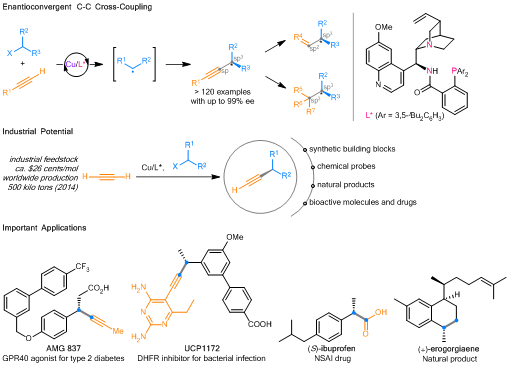Breakthrough in asymmetric radical chemistry by SUSTech researchers
2019-10-24
The role of organic chemistry in commercial and industrial applications is well known, but the importance of asymmetric carbon bond coupling is far less known. Thanks to researchers in Shenzhen, it appears that the opportunities for better welding equipment are not far away, due to improved understanding of free radical asymmetric chemistry.
Recently, Professor Xin-Yuan Liu from the Department of Chemistry at Southern University of Science and Technology (SUSTech) has led his research team to publish a breakthrough paper in Nature Chemistry, one of the preeminent academic journals on chemistry. The paper, titled “A general asymmetric copper-catalysed Sonogashira C(sp3)–C(sp) coupling,” aimed to examine asymmetric carbon–carbon (C–C) bond coupling.

The construction of C–C bonds is a basic research field in organic chemistry and has been the source of significant research. Three pioneers were recognized with the Nobel Prize in Chemistry in 2010, specifically “for palladium-catalyzed cross couplings in organic synthesis.” Previous studies into C–C bonds have focused on the coupling reaction of asymmetric alkyl carbon with a wide range of different carbons. However, very few studies have been conducted into the coupling reaction between alkyl carbon and alkynyl carbon. Alkynes are highly reactive and can convert in many different ways, potentially offering the rapid development of different carbon chiral centers.
The research team of Professor Xin-Yuan Liu decided to examine the Sonogashira coupling reaction, which is one of the most traditional alkyne coupling methodologies. It was chosen due to its use of simple resources and the avoidance of unexpected incompatibility problems. The team anticipated that the successful realization of the coupling reaction would be able to provide a high-quality complementary method for many of the reported asymmetric carbon to carbon bond coupling reactions.

To this end, the research group has managed to develop a catalyst system of Cu(I) and cinchona alkaloid-derived multidentate anionic ligand. This ligand not only provided an excellent chiral environment, but also significantly strengthened the reducing capability of the copper center. Accordingly, the research team was then able to easily obtain non-chiral alkyl radicals and successfully realize the stereoscopic aggregation of the Sonogashira C–C coupling reaction. Their reaction had a significantly wider range and excellent enantioselectivity (the degree of which one pair of chemical compounds is preferentially produced in a reaction).
The team also found that industrial feed stocks acetylene and propyne efficiently participated in this reaction, and thus, provides a solid foundation for the commercialization of the reaction in the future. In addition, there are also application of natural products, medicines and various other products that fully demonstrate the enormous potential of copper-catalyzed free radical reactions.
Recently, Professor Xin-Yuan Liu has published 11 articles in the Angewandte Chemie International Edition as a correspondent author. The editorial department has an exclusive interview. Due to Professor Xin-Yuan Liu’s contribution to free radical asymmetric chemistry, in June 2019, he was awarded the 2019 CAPA Distinguished Faculty Award (China) by the Chinese American Chemistry & Chemical Biology Professors Association (CAPA). In September, Professor Xin-Yuan Liu received an ACP Lectureship Award from the coordinators of Taiwan Province and Japan, respectively, as part of the 14th International Conference on Cutting-Edge Organic Chemistry in Asia for his contribution to radical-involved asymmetric chemistry. As a reward, he will be invited to deliver a series of lecture during one week visits to Taiwan Province and Japan.
Professor Xin-Yuan Liu was the correspondent author of the paper, and SUSTech was the communication unit. Financial support for this work was provided by the National Natural Science Foundation of China, Shenzhen Special Funds and Shenzhen Nobel Prize Scientists Laboratory Project.




